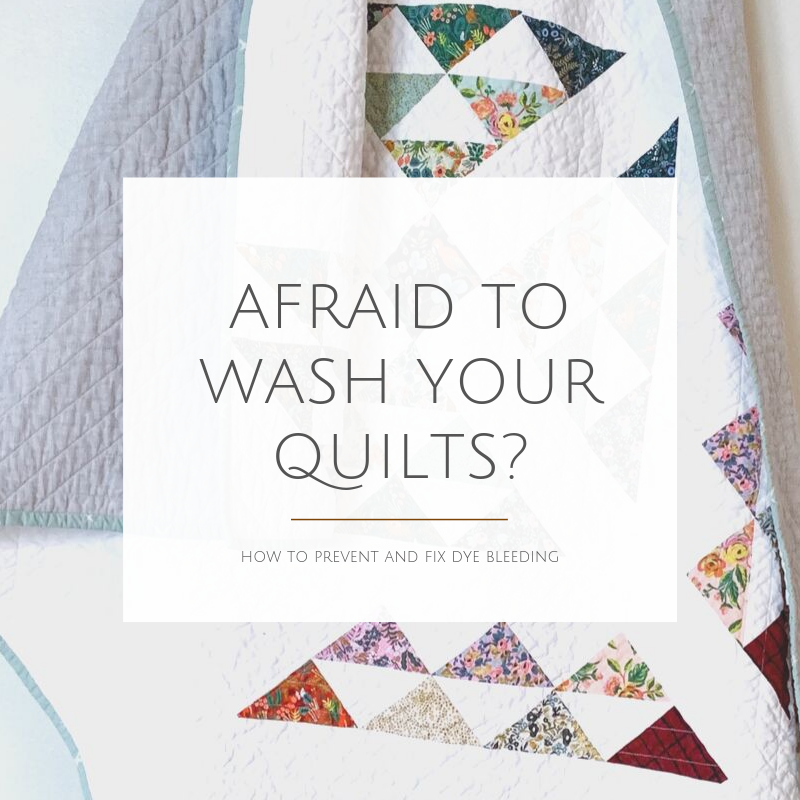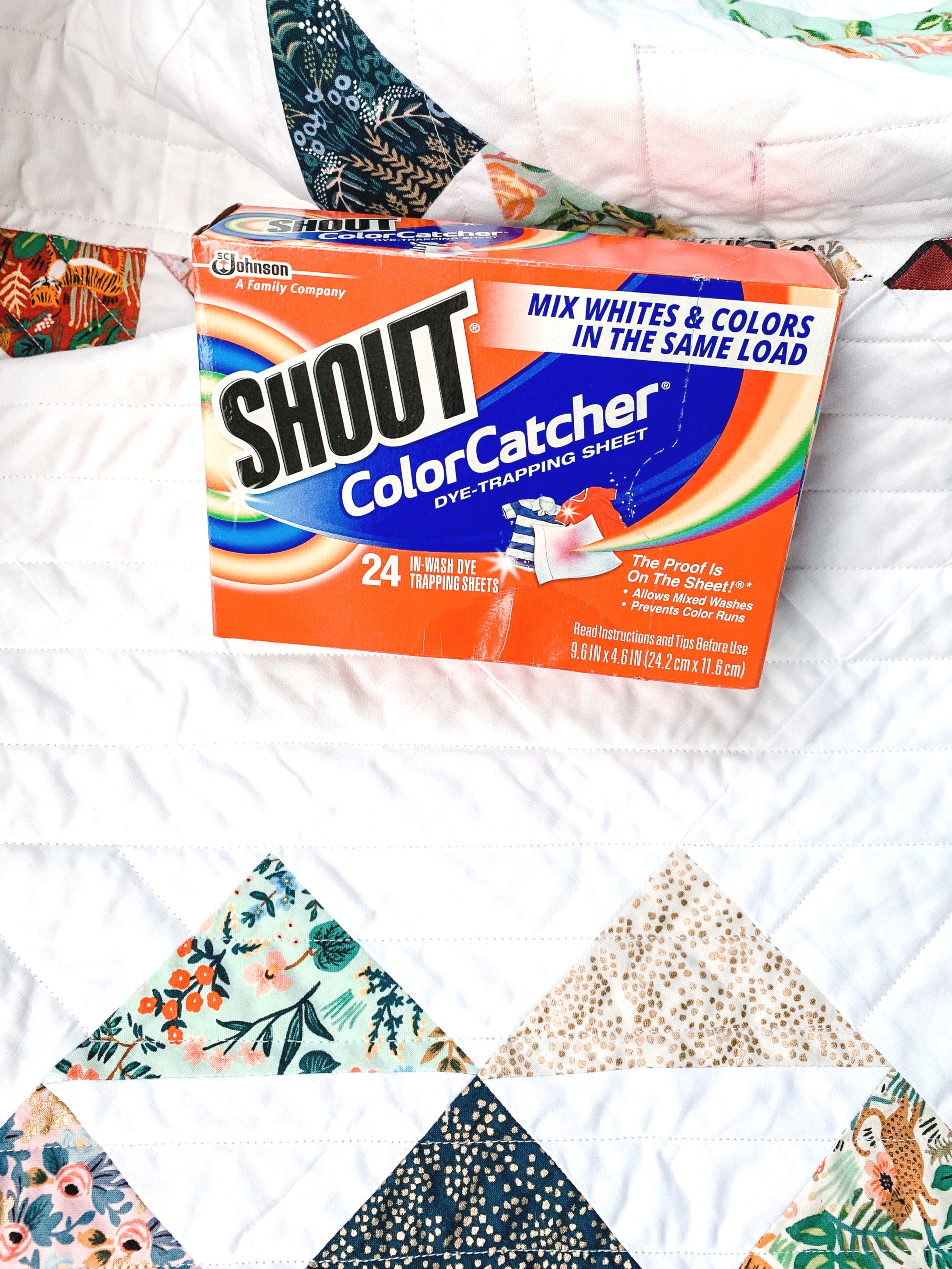Preventing & Fixing Dye Bleeds
There are always moments that make your heart stop a little when quilting, but I’m not sure there’s anything more horrifying than pulling your brand new finished quilt out of it’s first wash and realizing that your dye has bled. The first time this happened I sat on the laundry room floor and cried with a wet quilt in my lap. It was not super fun.
Luckily, after wallowing in my misery for a while I dove into research and problem solving. Since then, I’ve tested an assortment of solutions, and now I’m here to tell you about them! Please note that all of these are my personal experience, but there are a wide range of factors that can make each situation different. Make sure to read the instructions carefully for any product you use!
Dye solutions tend to fall into two categories: Things that help the dye set, and things that keep loose dye from sticking to your quilt (or help remove it once you’ve already had a mishap!). We’ll cover the pros and cons of both.
Prevent A Dye Bleed
Ideally, the best way to fix a dye bleed is to not have one to begin with! Preswashing is what responsible adult quilters do, but honestly… I usually don’t. I’m lazy, I’m tired, I have a toddler, and I don’t need to add more steps in my busy life! If I have a particularly concerning fabric I’ll test it and prewash if necessary. Here are the products I use to keep dye bleeds at bay, and correct them if they happen!
Retayne
Retayne is a product that helps to set the dye, and is best used when prewashing. I have definitely used Retayne before on a finished quilt, but generally that’s a no no and highly risky behavior. I have never had any issues with Retayne, but there are a few possible downsides that should be mentioned when talking about Retayne. There is some concern amongst home dyers that it reduce light fastness over time, but that seems to be up for debate (and even then, you’re basically just picking between wash or light fading). It took me years to notice this, but the directions say that the finished product should be washed exclusively with cold water after being treated or the dye retention will stop working. I’ve definitely thrown quilts treated with Retayne into a hot wash before and not noticed the dye fastness change, but that’s anecdotal evidence so proceed with caution.
Color Catchers
Color catchers have a cult like following in the quilting world for a reason- they work really well, and are low risk! They work by attracting loose dye floating around in the water, so you end up with a clean quilt and a dye filled color catcher. They’re fairly similar and interchangeable to synthrapol, though I do think that synthrapol does a better job at removing the excess dye. There aren’t many cons to Color Catchers though; they’re effective, they’re easy to find, and they’re easy to use.
A Note About Vinegar
Vinegar is often touted as a dye setting aide, but unfortunately it only works for acid-dyed fabrics and won’t help your quilting cottons. Don’t use vinegar with your quilts!
Uh oh, my quilt bled! Now what?
First things first: do NOT put a quilt in the dryer if the dye has run! Always check the first time you wash before tossing it in the dryer. That’s not to say that a dried quilt with dye bleeding isn’t salvageable (go on, ask me how I know), but it is much, much harder. Here are a couple solutions to try if you’ve had some bleeding:
Synthrapol
Synthrapol is a magical product that helps to separate loose dye from the fabric. It then suspends these particles of released dye in the water, keeping them from sticking where they don’t belong. If you’ve had some loose dye settle into the wrong areas of your quilt, more often than not a nice hot soak with some Synthrapol will remove it and help to get rid of any other loose dye as well.
Dawn Ultra Pure Dish Soap
After having an extremely messy small person living in my house I’ve learned that there aren’t many stains that can’t be vanquished by some good old dawn dish soap. While I tend to have the best luck with Synthrapol, the last time I had a bad dye bleed there was a slight shadow left behind after my first round of Synthrapol that was taken care of with some dish soap. Apply it liberally to the spot, let it sit for a bit, and then wash.
If your head is still spinning a bit with all of these options, here’s a good general methodology to follow:
1) Test your fabric! If you have a fabric that seems suspicious (vivid colors seem to be the worst culprits), cut a small swatch, soak it with water, and squeeze it with a white paper towel or piece of fabric. If there’s any bleeding, best to prewash that particular fabric with Retayne.
2) Wash your finished quit with a color catcher. If any color appears on the color catcher, use another one next time you wash until the color catcher remains white.
3) If some loose dye has escaped your color catcher and you have bleeding, put your quilt right back in the washer with some really hot water and use Synthrapol.
4) If stains persist, try a spot treatment of dawn dishsoap, or if you want some extra oomph I’ve had great success with equal parts hydrogen peroxide (3% only please!) and dawn dish soap. Let it sit for a few minutes, then rewash. Disclaimer - some people have had bad luck with hydrogen peroxide! Please test it in an unobtrusive spot first, and use it as a last resort.
There you have it! Hopefully you now feel empowered to wash your quilts without extreme anxiety. And if this was too much to read, the TL;DR is this: Color catchers are easy. They work. Use them.





